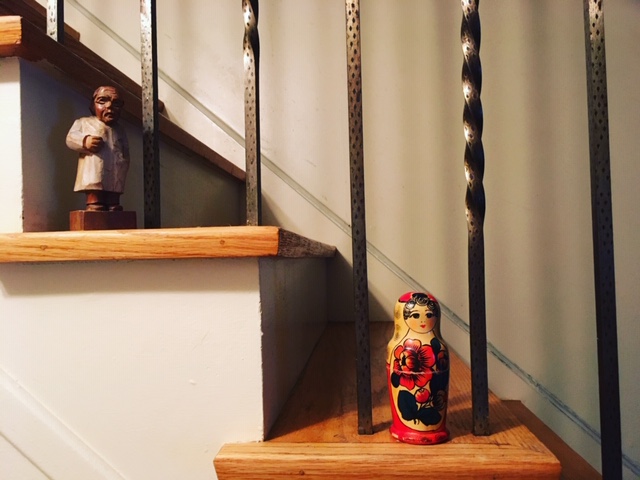When we were young, we had a series of older ladies as babysitters. My father was a politician and my mother was his press secretary and a volunteer in the church, in healthcare and in the wider community. When our parents were away or busy, these older ladies cared for us and eventually became our adopted family. Our own grandmothers lived far away.
Mrs Rypalowski was one of these grand-ladies. In addition to babysitting, she had a small hair salon in her home. She also taught people to decorate pysanky, otherwise known as Ukrainian Easter eggs. I loved her art. Many years later, I still have a pysanka she made which is safely displayed on an upper shelf.

When I was little, Mrs Rypalowski’s son, John, was grown. Unlike some of our other caregivers, she didn’t have a lot of toys in her home. She did have an amazing dog, Paddy, who only understood Ukrainian. (I still remember how to say “shake a paw” in that language.) She also had a set of Ukrainian nesting dolls or matryoshka dolls. She let me play with them as long as I was careful. I loved those dolls.
The first set of nesting dolls arrived in my home many years as a Birthday gift for my oldest daughter who was turning 5. Aria’s uncle Jeff had found them in the International Pavilion at the Canadian National Exhibition in Toronto. A few years later, they were joined by a Russian set of nesting dolls that my oldest brother Mark purchased while on a trip across Russia. He presented a more ornate set to my mother. When she died, the dolls were passed on to me.
This past Easter Sunday, as I reflected on our celebration limited by circumstances, the dolls came to mind. I thought of how difficult it would be for these little families to be apart. They were made to be together. I also reflected on what they meant to me personally. They were quiet reminders of important people in my life: my mother, Mark and of Mrs Rypalowski who though gone, are still loved and cherished. In the dolls, I recognized the world’s need for love, family, beauty, protection and connection.
Our dolls had never been named. The matriarchs are now known as Albena, Varya and Victoriya. These names symbolize connection with friends, family and co-workers past and present. The trio has been sharing insights in photos on social media. If those who have spent their whole lives together can be separate for now for the greater good, we can too.

physical distancing 
Victoriya’s garden 
Albena shopping responsibly
Albena, Varya and Victoriya wish you love, connection and health today and everyday. For those celebrating Orthodox Easter today, Happy Easter from all of us!
If you are curious on how these art pieces are made, here is a short video featuring artisans crafting dolls. Dolls Albena and Victoriya likely came into being there.



This is such a beautiful story. Thanks for sharing it.
LikeLike